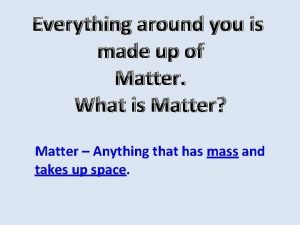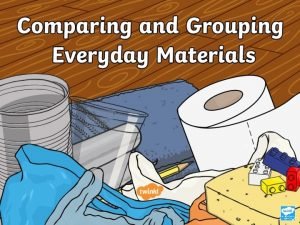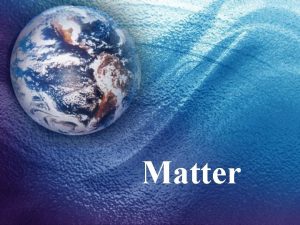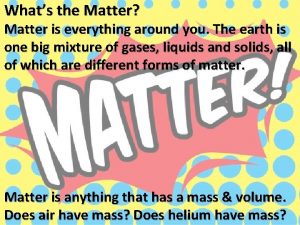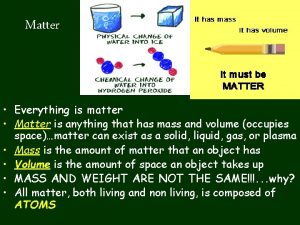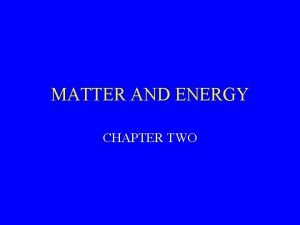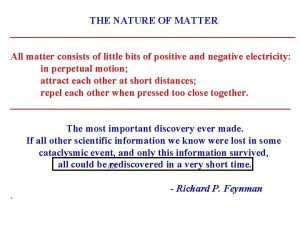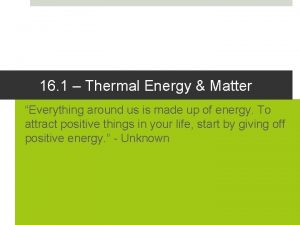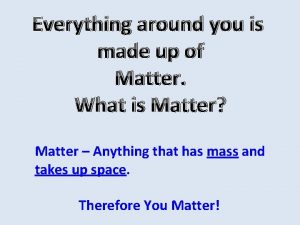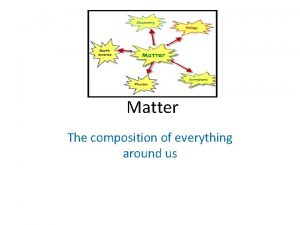What is matter Everything around us consists of


















- Slides: 18


What is matter? Everything around us consists of matter For example: our school books your classmates but also the air the planets and the stars

THE THREE STATES OF MATTER Matter is made of tiny particles and it can be grouped into different shapes SOLID LIQUID For example WOOD STONE MILK GAS For example WATER VAPOR HELIUM

SOLID Particles in a solid are placed in an orderly manner and can not change their position. A solid has a definite shape and a definite volume that doesn’t change when you move it or put it in a container.

LIQUID The particles are not blocked in their position but they are free and can slide relative to one another. Liquids have a definite volume but they don’t have a definite shape; they take it from their containers

GAS The particles can move freely in all directions, occupying the entire volume available. Gasses don’t have a definite shape or volume. Like liquids, gasses take the shape of their containers.

SOLID LIQUID GAS

Classify the substances in the corresponding column • • • • • Orange juice Mineral Oxygen Coffee Stone Air Water vapour Water Hydrogen Wood Milk Glass Sea water Rubber Carbon dioxide Cola Ice Helium SOLIDS LIQUIDS GASSES

Group Work § cut each square out § identify the right substance § glue the substance in the corresponding sheet

Classify the substances in the corresponding column • • • • • Orange juice Mineral Oxygen Coffee Stone Air Water vapour Water Hydrogen Wood Milk Glass Sea water Rubber Carbon dioxide Cola Ice Helium SOLIDS LIQUIDS GASSES Mineral Orange juice Oxygen Stone Wood Coffee Water Air Water vapour Glass Milk Hydrogen Rubber Sea water Carbon dioxide Ice Cola Helium


Some matter can change form. A solid can become a liquid and a liquid can become a gas. Heat causes these changes. These phenomena are called changes of state. Water is a good example of this phenomenon.

EXERCISE Read the passage and fill in the blanks with the missing words Some matter can change …………. . A solid can become a …………. . and a liquid can become a gas. …………. . causes these changes. …………… is a good example of how matter can have these three different states. Water liquid Heat form

CHANGES OF STATE TIO CA N SO LID TIO IFI M EL T N IN G SA N EN TIO ND RA CO O AP EV LIQUID SUBLIMATION DEPOSITION SOLID GAS

EXERCISE Look at the diagram and complete the text using the word box Matter can change states by adding and subtracting heat. What happens if you heat ice? It changes to water. This change is called … If you heat water, it changes to water vapour. This change is called …… If you cool water vapour, it changes to ice. This change is called …… If you heat ice, it changes to water vapour. This change is called …… If you cool water vapour, it changes to water. This change is called …. . If you cool water, it changes to ice. This change is called …. . EVAPORATION DEPOSITION SOLIDIFICATION MELTING SUBLIMATION CONDENSATION

Pair work. Find and match the following definitions It is the change from liquid to solid It is the change from gas to liquid It is the change from liquid to gas Melting Solidification Sublimation It is the change from solid to gas Evaporation It is the change from gas to solid Deposition It is the change from solid to liquid Condensation


 Everything around us is made up of
Everything around us is made up of We will not be moved when everything around is shaking
We will not be moved when everything around is shaking Everything around us
Everything around us Everything which surrounds us referred as
Everything which surrounds us referred as Everything around you is made up of
Everything around you is made up of Examples of what goes around comes around
Examples of what goes around comes around Goes around comes around meaning
Goes around comes around meaning Gray matter and white matter
Gray matter and white matter White matter
White matter Classification of matter section 1 composition of matter
Classification of matter section 1 composition of matter Composition of matter section 1
Composition of matter section 1 Gray matter and white matter
Gray matter and white matter Chapter 2 matter section 1 classifying matter answer key
Chapter 2 matter section 1 classifying matter answer key Ecological succession
Ecological succession Ncl. caudatus
Ncl. caudatus Section 1 composition of matter
Section 1 composition of matter Everything in asl
Everything in asl What happened is everything ok
What happened is everything ok Checklists for everything
Checklists for everything
